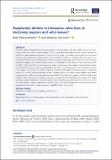Population decline in Lithuania : who lives in declining regions and who leaves?
Abstract
Since the 1990s, Lithuania lost almost one-quarter of its population, and some regions within the country lost more than 50% of their residents. Such a sharp population decline poses major challenges to politicians, policy-makers and planners. The aim of this study is to obtain more insight into the recent processes of socio-spatial change and the role of selective migration in Lithuania. The main focus is on understanding who lives in those regions which are rapidly losing population, and who is most likely to leave these regions. This is one of the first studies to use individual-level Lithuanian census data from 2001 and 2011. We found that low socio-economic status residents and older residents dominate the population of shrinking regions, and unsurprisingly that the most ‘successful’ people are the most likely to leave such regions. This process of selective migration reinforces the negative downward spiral of declining regions. As a result, socio-spatial polarization is growing within the country, where people with higher socio-economic status are increasingly overrepresented in the largest city-regions, while the elderly and residents with a lower socio-economic status are overrepresented in declining rural regions. This paper provides empirical evidence of selective migration and increasing regional disparities in Lithuania. While the socio-spatial changes are obvious in Lithuania, there is no clear strategy on how to cope with extreme population decline and increasing regional inequalities within the country.
Citation
Ubarevičienė , R & Van Ham , M 2017 , ' Population decline in Lithuania : who lives in declining regions and who leaves? ' , Regional Studies, Regional Science , vol. 4 , no. 1 , pp. 57-79 . https://doi.org/10.1080/21681376.2017.1313127
Publication
Regional Studies, Regional Science
Status
Peer reviewed
Type
Journal article
Description
This work was supported by the Marie Curie programme under the European Union’s Seventh Framework Programme (FP/2007-2013)/Career Integration Grant [grant number PCIG10-GA-2011-303728] (CIG Grant NBHCHOICE, Neighbourhood choice, neighbourhood sorting, and neighbourhood effects).Collections
Items in the St Andrews Research Repository are protected by copyright, with all rights reserved, unless otherwise indicated.

